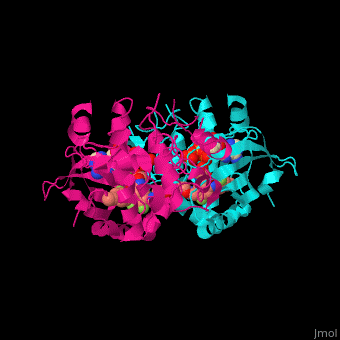Mitogen-activated protein kinase kinase
From Proteopedia
FunctionMitogen-activated protein kinase kinase or dual specificity mitogen-activated protein kinase kinase (MAP2K; MEK1 or MEK2)) are serine/threonine kinases which regulate various cellular activities in response to extracellular stimuli by mitogens, heat shock and more. MAP2K is part of the MAPK cascade which consists also of MAPK and MAP3K which are activated by phosphorylation. The PB1 domain at the N-terminal of MAP2K is involved in the heterodimerization and is required for the formation of macromolecular signalling complexes which ensure specificity and fidelity during cellular signalling[1]. MAP2K activates MAPK[2],[3].
RelevanceMAP2K is activated in melanoma and its inhibitors are tested as therapeutical agents[4]. DiseaseMAP2K4 mutations are seen in many types of cancer and particularly in breast cancer[5].
Structural highlightsThe biological assembly of Human MAP2K1 is homodimer. MAP2K inhibitors interact with the active site ATP[6]. 3D Structures of Mitogen-activated protein kinase kinase |
| |||||||||||
Mitogen-activated protein kinase kinase 3D structures
References
- ↑ Moscat J, Diaz-Meco MT, Albert A, Campuzano S. Cell signaling and function organized by PB1 domain interactions. Mol Cell. 2006 Sep 1;23(5):631-40. doi: 10.1016/j.molcel.2006.08.002. PMID:16949360 doi:http://dx.doi.org/10.1016/j.molcel.2006.08.002
- ↑ Weyman CM, Wolfman A. Mitogen-activated protein kinase kinase (MEK) activity is required for inhibition of skeletal muscle differentiation by insulin-like growth factor 1 or fibroblast growth factor 2. Endocrinology. 1998 Apr;139(4):1794-800. PMID:9528964 doi:http://dx.doi.org/10.1210/endo.139.4.5950
- ↑ Zheng CF, Guan KL. Properties of MEKs, the kinases that phosphorylate and activate the extracellular signal-regulated kinases. J Biol Chem. 1993 Nov 15;268(32):23933-9. PMID:8226933
- ↑ Falchook GS, Lewis KD, Infante JR, Gordon MS, Vogelzang NJ, DeMarini DJ, Sun P, Moy C, Szabo SA, Roadcap LT, Peddareddigari VG, Lebowitz PF, Le NT, Burris HA 3rd, Messersmith WA, O'Dwyer PJ, Kim KB, Flaherty K, Bendell JC, Gonzalez R, Kurzrock R, Fecher LA. Activity of the oral MEK inhibitor trametinib in patients with advanced melanoma: a phase 1 dose-escalation trial. Lancet Oncol. 2012 Aug;13(8):782-9. doi: 10.1016/S1470-2045(12)70269-3. Epub 2012, Jul 16. PMID:22805292 doi:http://dx.doi.org/10.1016/S1470-2045(12)70269-3
- ↑ Su GH, Song JJ, Repasky EA, Schutte M, Kern SE. Mutation rate of MAP2K4/MKK4 in breast carcinoma. Hum Mutat. 2002 Jan;19(1):81. PMID:11754110 doi:http://dx.doi.org/10.1002/humu.9002
- ↑ Isshiki Y, Kohchi Y, Iikura H, Matsubara Y, Asoh K, Murata T, Kohchi M, Mizuguchi E, Tsujii S, Hattori K, Miura T, Yoshimura Y, Aida S, Miwa M, Saitoh R, Murao N, Okabe H, Belunis C, Janson C, Lukacs C, Schuck V, Shimma N. Design and synthesis of novel allosteric MEK inhibitor CH4987655 as an orally available anticancer agent. Bioorg Med Chem Lett. 2011 Jan 21. PMID:21316218 doi:10.1016/j.bmcl.2011.01.062

